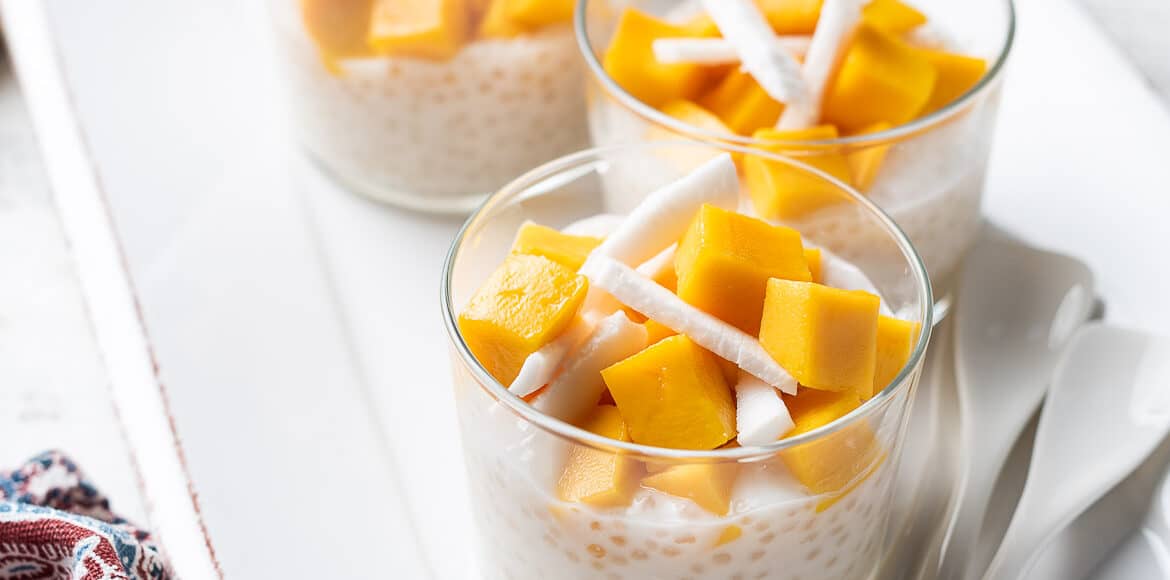
Mango Coconut Tapioca Pudding
Mango Coconut Tapioca Pudding – If you love the classic Thai dessert mango and sticky rice, this pudding recipe is for you! A light and silk coconut cream bursts with tiny tapioca pearls and sweet, fresh mango, and is from Sabai: 100 Simple Thai Recipes for Any Day of the Week by Pailin Chongchitnant. You’ll love how simple it is to whip together when you’re craving those mango and coconut flavors!
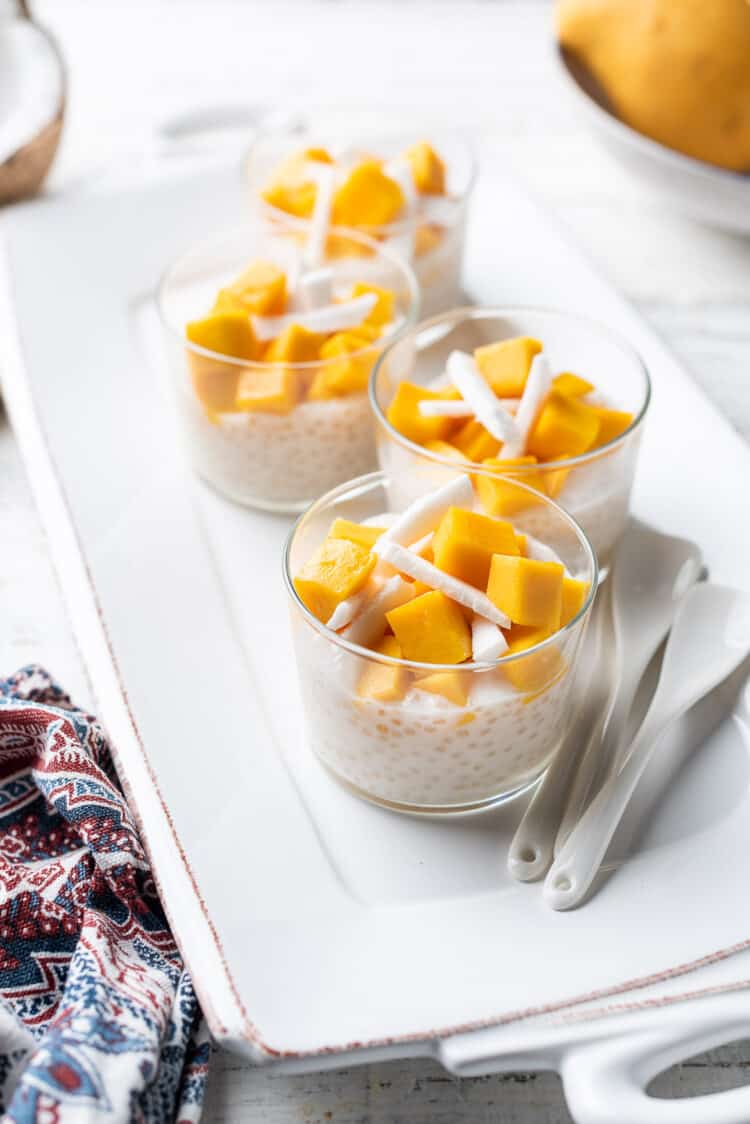
Mango Coconut Tapioca Pudding – If you love the classic Thai dessert mango and sticky rice, this Thai coconut sago pudding is for you! Coconut tapioca pudding is made with a light, silky coconut cream bursting with tiny tapioca pearls and topped with sweet, fresh mango. This mango sago pudding is from Sabai: 100 Simple Thai Recipes for Any Day of the Week by Pailin Chongchitnant.
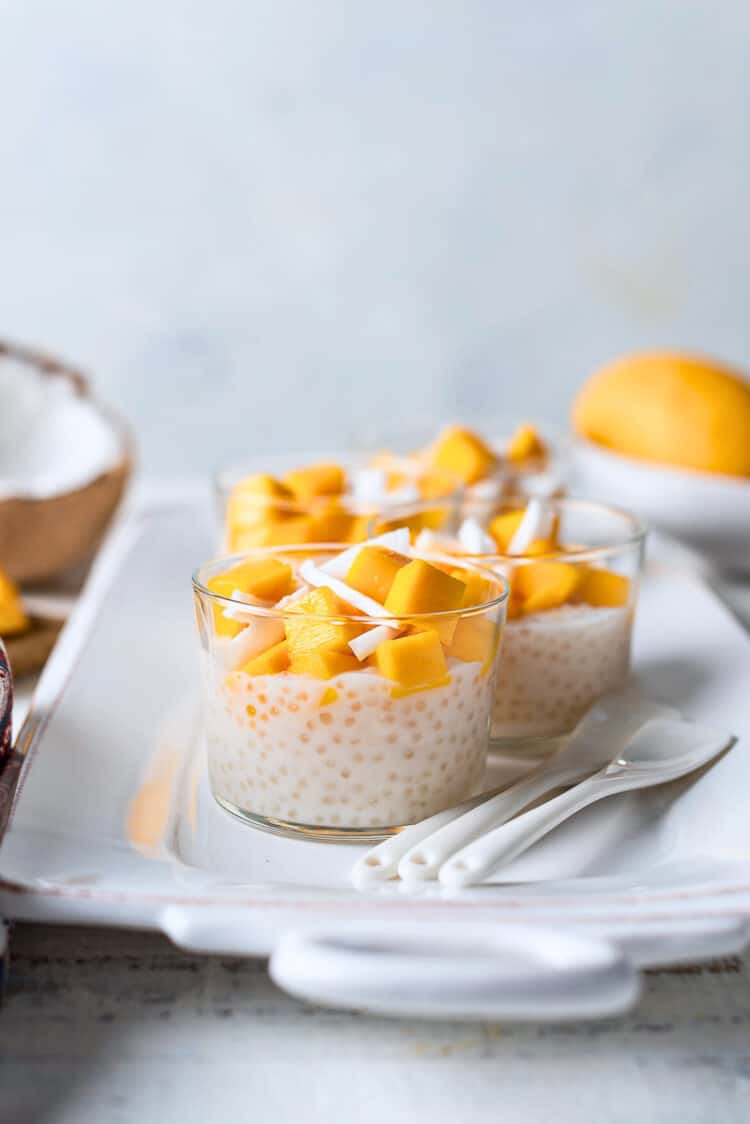
Mango Coconut Tapioca Pudding (Pudding Sakoo Mamuang Sohd – พุดด้ิงสาคูมะม่วงสด)
I often delight in the similarities between Thai and Filipino cuisine. There are many common threads in Southeast Asian cooking (and eating), which may explain why I often crave and love to cook Thai dishes almost as often as I do my family’s favorite Filipino recipes. Take the ingredients, for example. We share a love for rice, coconut milk, fish sauce, soy sauce, shrimp paste, and noodles, to name a few. Don’t even get me started on mangoes and banana leaves! And we eat with a fork and a spoon – an efficient method for ensuring that each flavorful grain of rice and sauce never goes to waste!
I was happy to welcome Pailin Chongchitnant to the podcast to discuss these similarities, the secret to her success of Pailin’s Kitchen on YouTube, and her newly released cookbook.
Sabai: 100 Simple Thai Recipes for Any Day of the Week (affiliate link) is Pai’s answer to easy, approachable Thai recipes that anyone can cook on a weeknight. I found myself bookmarking many recipes, from savory classics like Massaman Curry to her version of a mango sago pudding, which I am so excited to share with you today.
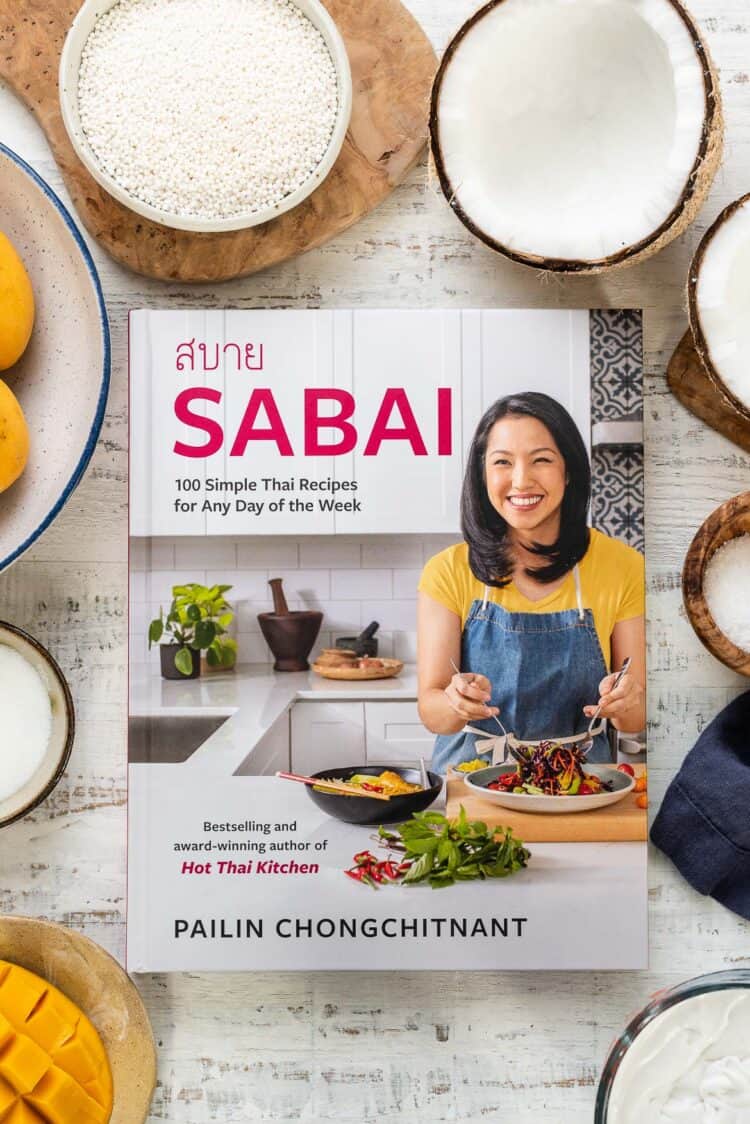
How to Make Mango Coconut Tapioca Pudding
Mango sticky rice is a classic staple in Thai cooking, but it requires time and planning. Sometimes you need something sweet and refreshing — and quick! So, this recipe for Mango Coconut Tapioca Pudding is the answer.
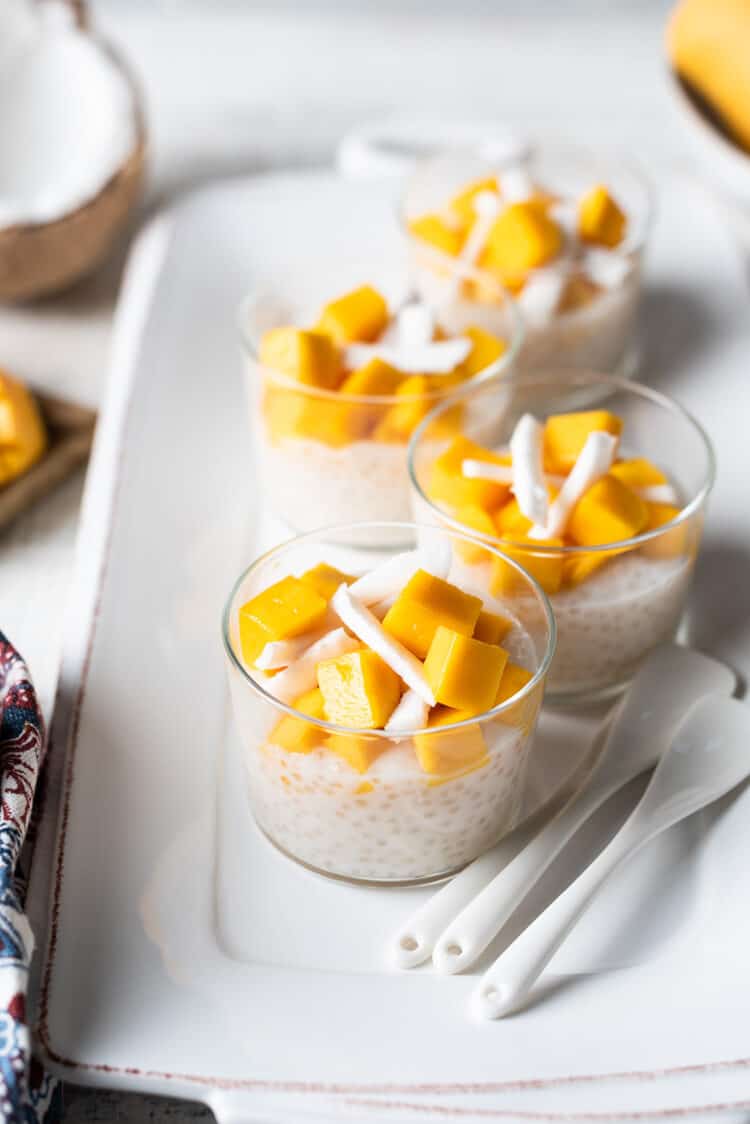
Pailin was inspired by the tapioca-mango dessert cups often sold at Chinese supermarkets. Tiny tapioca pearls are folded into a silky coconut cream and topped with fresh, juicy mango, providing that same fantastic coconut-mango flavor with an entirely different texture and experience.
One important note is that tapioca pearls lose their soft chewy texture in the fridge, so you’ll want to make this recipe right before you plan to eat it.
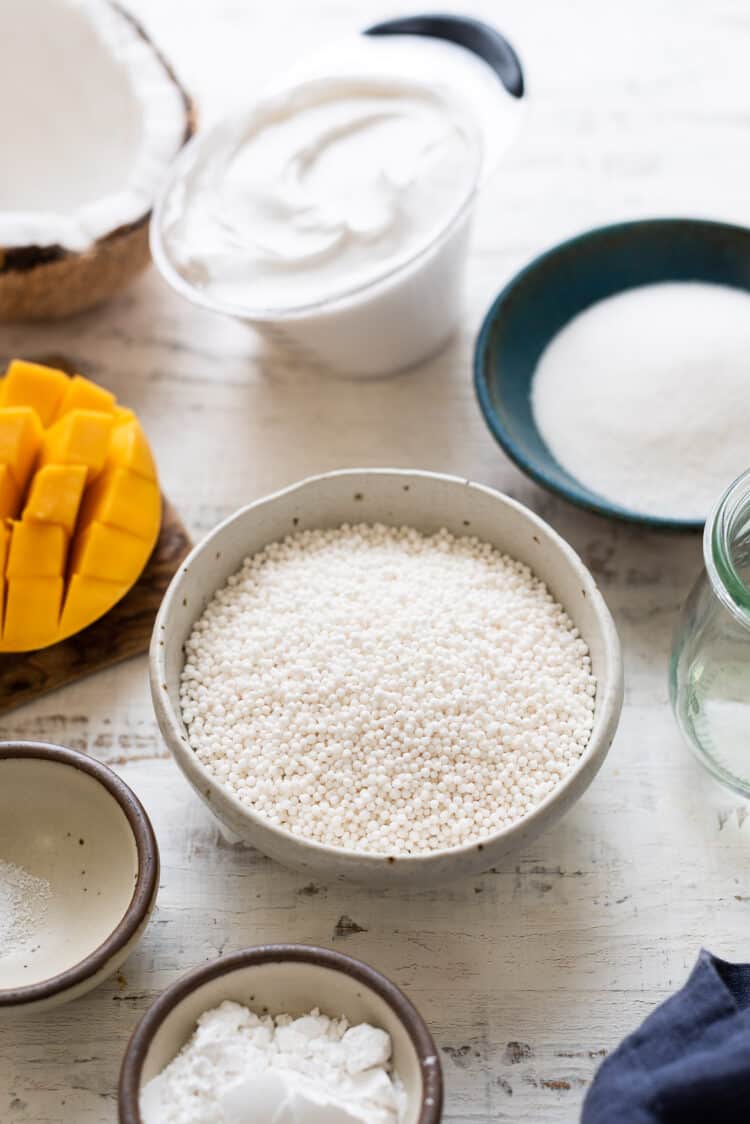
How to Make Mango Coconut Tapioca Pudding
- Make the coconut cream
Pour the coconut milk into a small pot, add one knotted pandan leaf, and bring the coconut milk to a boil. Once they are boiling, stir in the sugar and salt until fully dissolved.
While the milk is boiling, dissolve rice flour in water. Pour the dissolved rice flour mixture into the coconut milk mixture to thicken. Stir continuously with a rubber spatula until the mixture returns to a boil and thickens. Remove from heat, remove the pandan leaf, and allow to cool.
You can make the coconut cream up to three days ahead of time if you wish. - Cook the tapioca pearls
Start by bringing a pot of water to a full boil and add the tapioca pearls. Please note, the water must come to a full boil before you add the tapioca pearls. If you add them before the water is boiling, they’ll dissolve, stick together, and turn into a mushy mess instead of gelling up.
Stir the pearls until the water returns to a boil. Once boiling, stop stirring and let the pearls cook for about 12–13 minutes.
While the pearls are boiling, get a bowl of cold water ready. When you think the pearls might be done cooking, remove several from the pot and add to the bowl of cold water. You’ll know the pearls are done cooking when any white centers remaining in the pearls look no larger than a tiny dot.
When ready, drain the pearls in a fine strainer or sieve and run cold water over them until completely cool. Shake off any excess water. Transfer them to a mixing bowl. Leave covered for up to four hours until you are ready to serve. Do not refrigerate. - Assemble and serve the pudding
Once the coconut cream has cooled to be warm, room temperature, or cold if it was refrigerated, mix together the cream, the tapioca pearls, and the young coconut meat. Taste the pudding with a piece of mango and add any salt or sugar as needed.
Spoon the pudding into a serving bowl and top with a generous serving of mango pieces.
The tapioca pearls will continue to absorb moisture from the cream the longer it sits, so be sure to serve within 30 minutes of mixing the pudding together. Leftovers can be stored in the fridge but know that the texture won’t be the same the next day!
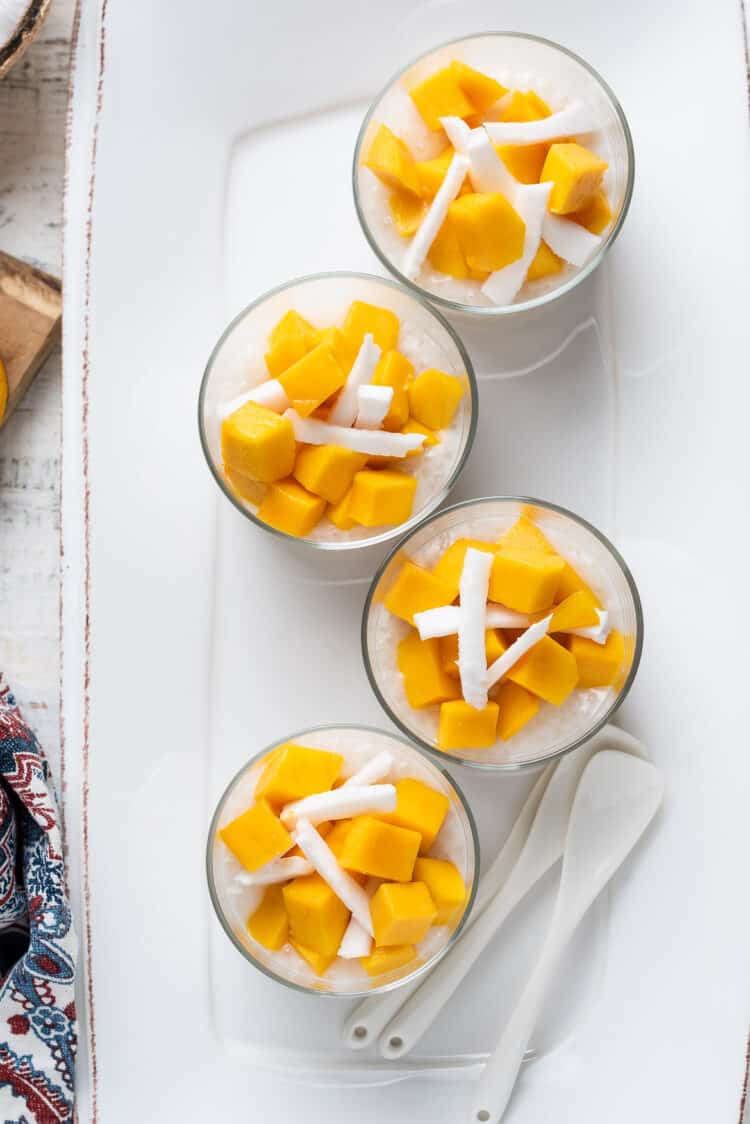
Listen to the Podcast with Pai
For more simple Thai recipes and to learn more about Sabai, check out my interview with Pailin in Episode 67 of the Kitchen Confidante Podcast!
More Thai-inspired Recipes
Sweet Coconut Sticky Rice with Mango
Thai-Curry Marinated Grilled Shrimp
Thai-style Shrimp Bowls
More Coconut Dessert Recipes
Coconut Tapioca Pudding with Strawberry Rhubarb Compote
Ginataang Bilo-Bilo: Filipino Coconut Tapioca Pudding
10 Easy Filipino Desserts with Coconut Milk
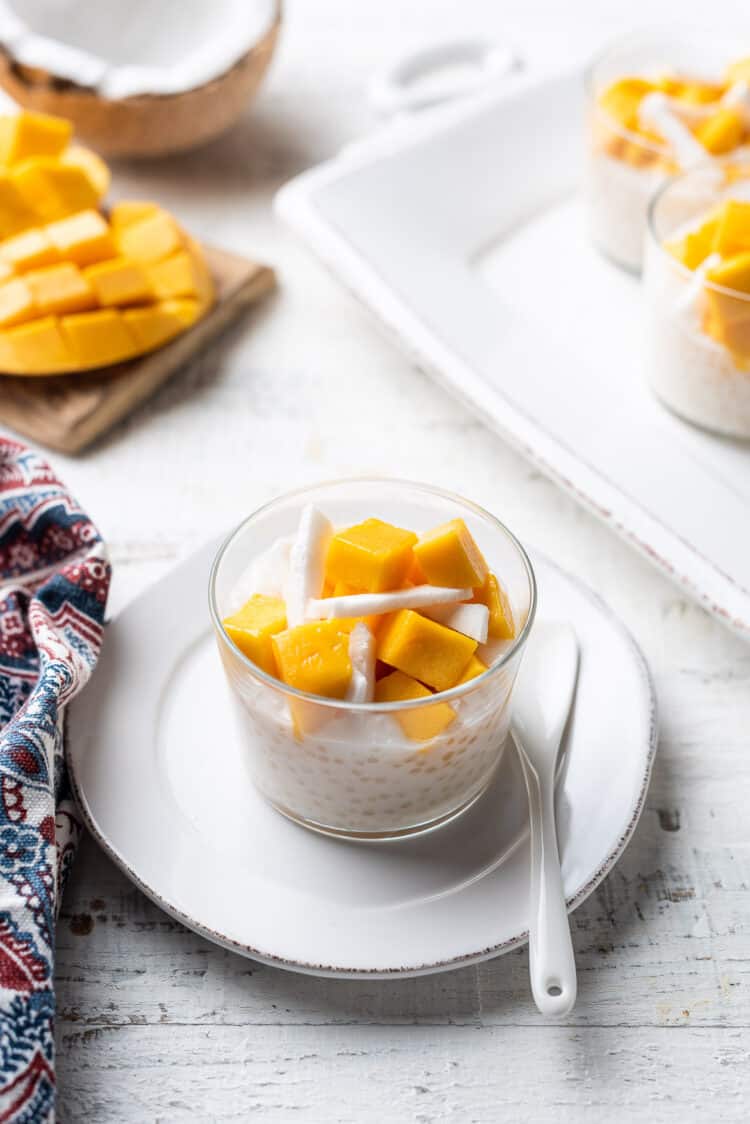
Disclosure: I was sent a copy of Sabai: 100 Simple Thai Recipes for Any Day of the Week to review for the Kitchen Confidante Podcast Episode 67 with Pailin Chongchitnant. All opinions are, of course, my own. The post may have affiliate links; see my Disclosure page to learn more.
Mango Coconut Tapioca Pudding (Pudding Sakoo Mamuang Sohd – พุดด้ิงสาคูมะม่วงสด)
Ingredients
- 1 cup coconut milk (250 ml)
- 1 pandan leaf tied into a knot (optional; see note below )
- 5 to 7 tablespoons finely chopped palm or granulated sugar (62 to 75 g; see note below)
- 1/4 teaspoon table salt (1 ml)
- 2 tablespoons rice flour (15g)
- 2 tablespoons water (30 ml)
- 1/2 cup small tapioca pearls (85 g; see note)
- 1/2 cup julienned young coconut meat, fresh or canned (10 g)
- 2 to 3 sweet ripe mangoes cut in 1⁄2-inch (1.2 cm) cubes
Instructions
Make the coconut cream
- Make the coconut cream by placing the coconut milk and pandan leaf in a small pot and bringing the milk to a boil over medium heat. Add the sugar and salt; stir until dissolved.
- Dissolve the rice flour in the water, then pour it into the coconut milk while you stir with a rubber spatula. Keep stirring constantly until the coconut milk returns to a boil and the mixture has thickened. Remove the coconut cream from the heat, discard the pandan leaf, and let cool.
Make the tapioca pearls
- Bring at least 6 cups (1.5 L) water to a full boil over high heat to cook the tapioca pearls.Sprinkle the tapioca pearls into the boiling water and stir until the water returns to a boil. Then stop stirring and let them boil for 12 to 13 minutes. Meanwhile, prepare a small bowl of cold water to check doneness.
- Check the doneness of the pearls by putting a small amount into the cold water. The pearls are done when any white centers remaining in the pearls look no larger than a tiny dot.
- Drain the pearls through a metal fine-mesh sieve and run cold water through them until completely cool. Shake off excess water and transfer to a mixing bowl. If you’re not ready to serve, you can leave them at room temperature, covered, for up to 4 hours. For the best texture, it’s better to not refrigerate them.
Assemble the pudding
- To assemble, stir the coconut cream (it can be warm, room temperature, or cold) and the young coconut meat into the pearls, mixing well. You can taste the pudding with a piece of mango and add more sugar and/or salt as needed, depending on the sweetness and tartness of the mangoes.
- Spoon into a small serving bowl and top with a generous helping of mango pieces. Serve within 30 minutes of mixing. The tapioca pearls will continue to absorb moisture from the cream as they sit, so the longer they sit, the less soft and creamy the texture will be. If you have any leftovers, you can store them in the fridge, but the texture will not be as good the next day.
Notes
- You can make the coconut cream up to three days ahead of time. Store it in the refrigerator before assembling it.
- You can make the tapioca up to four hours before; store it at room temperature and do not refrigerate it.
- Chop up the mango and coconut meat three days before, and store it in the refrigerator.
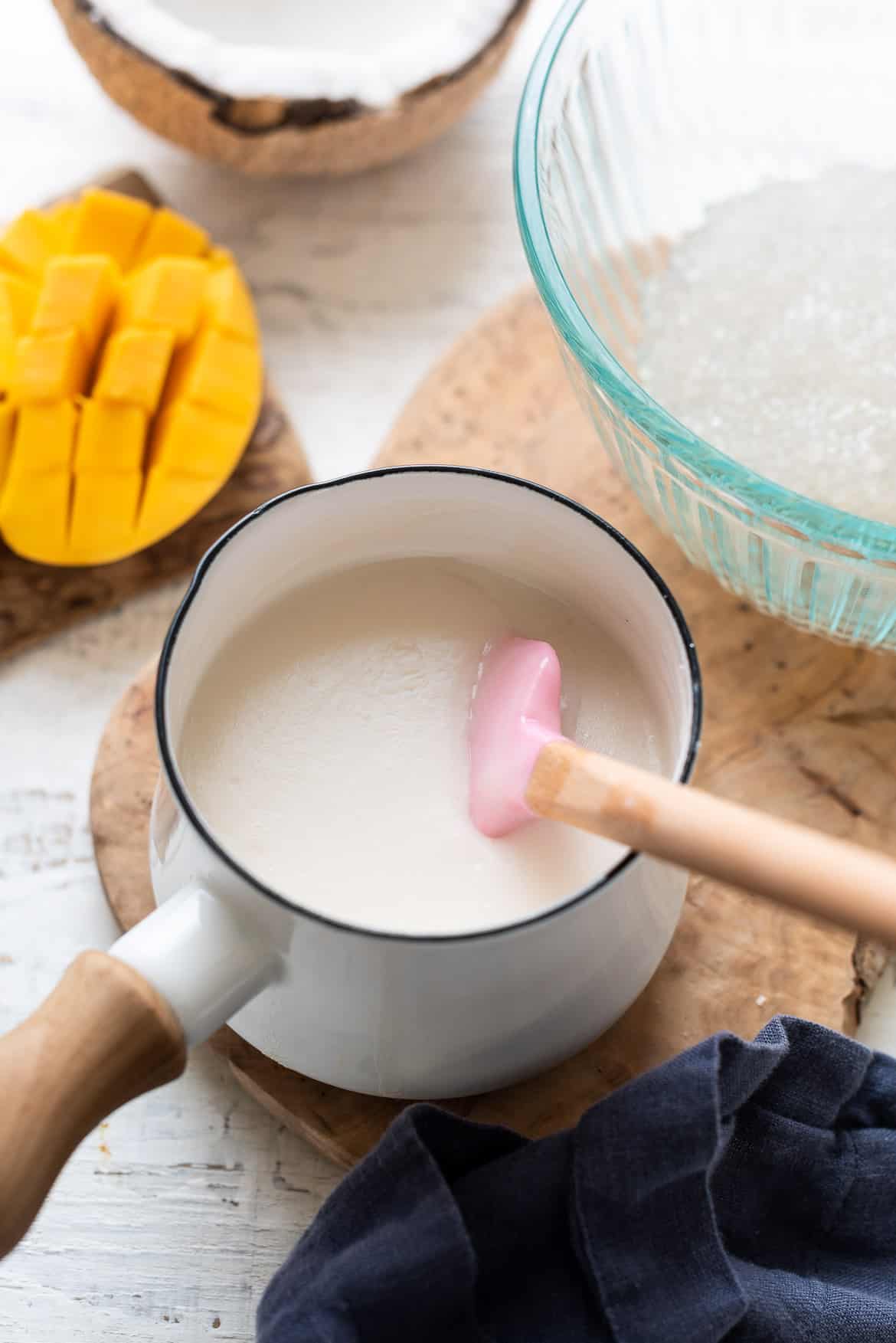
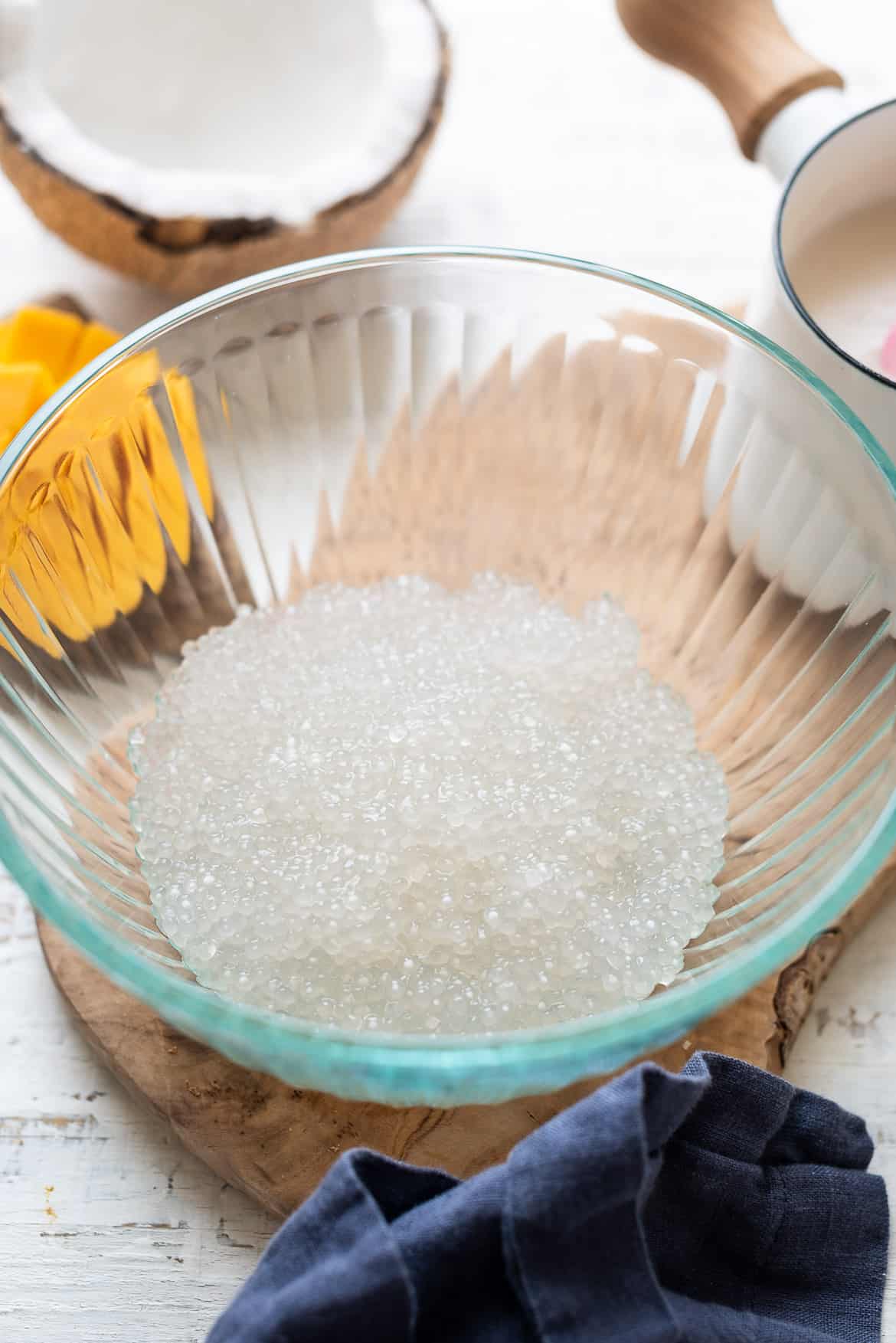
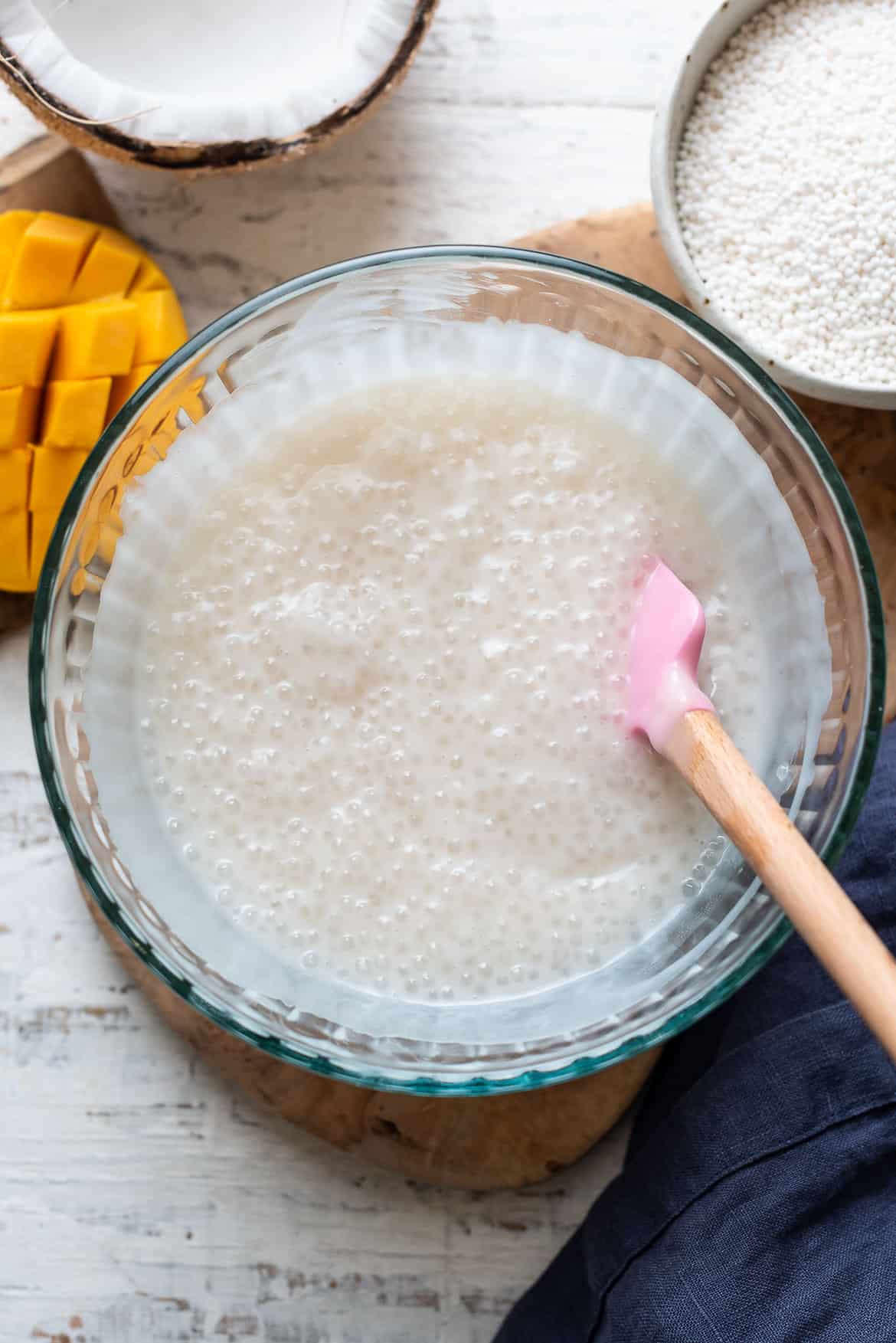
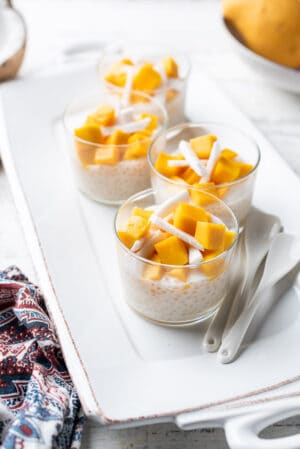



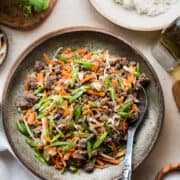
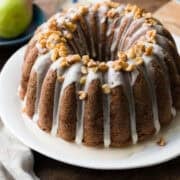
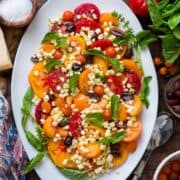
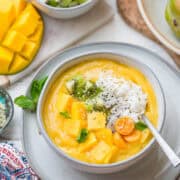

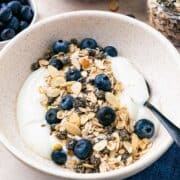
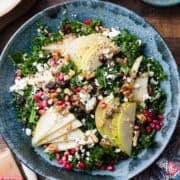
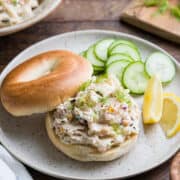






Comments